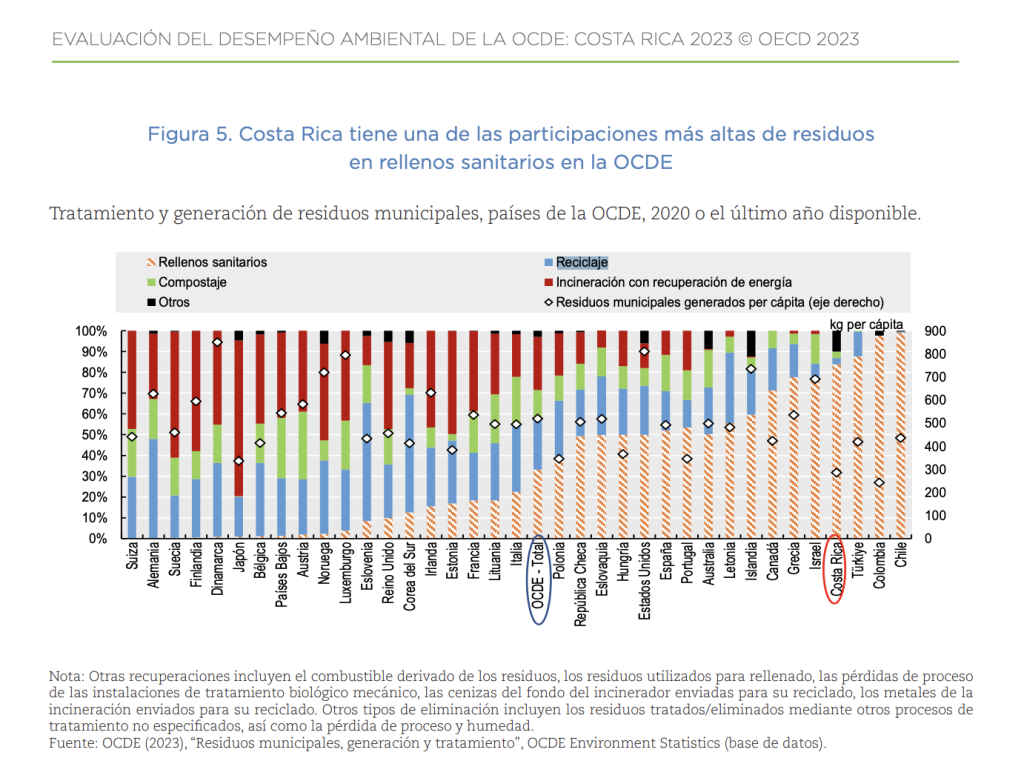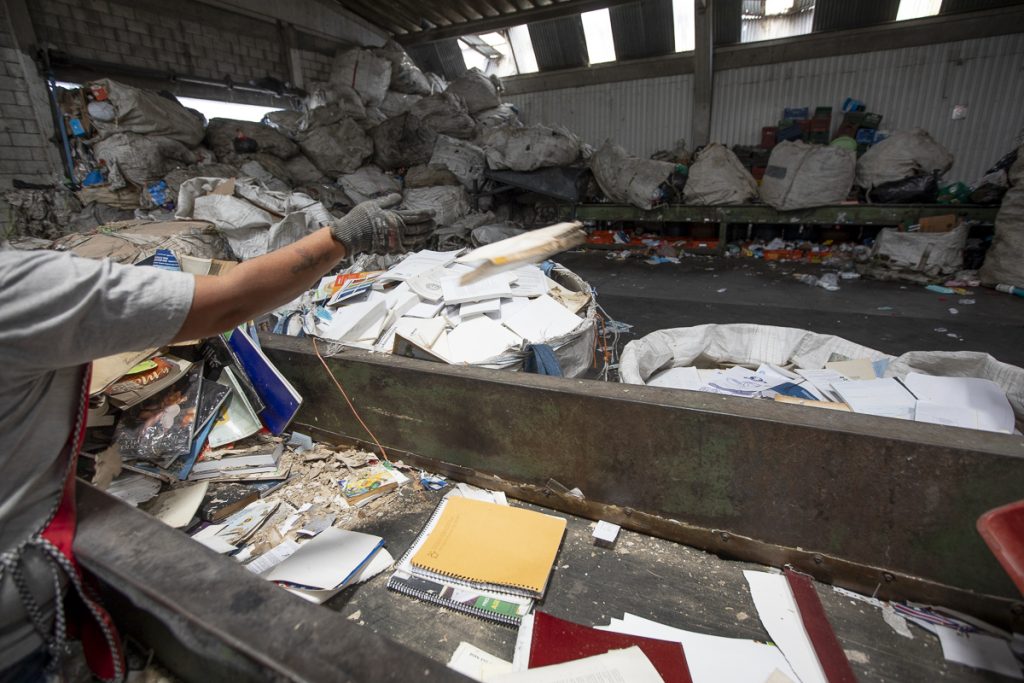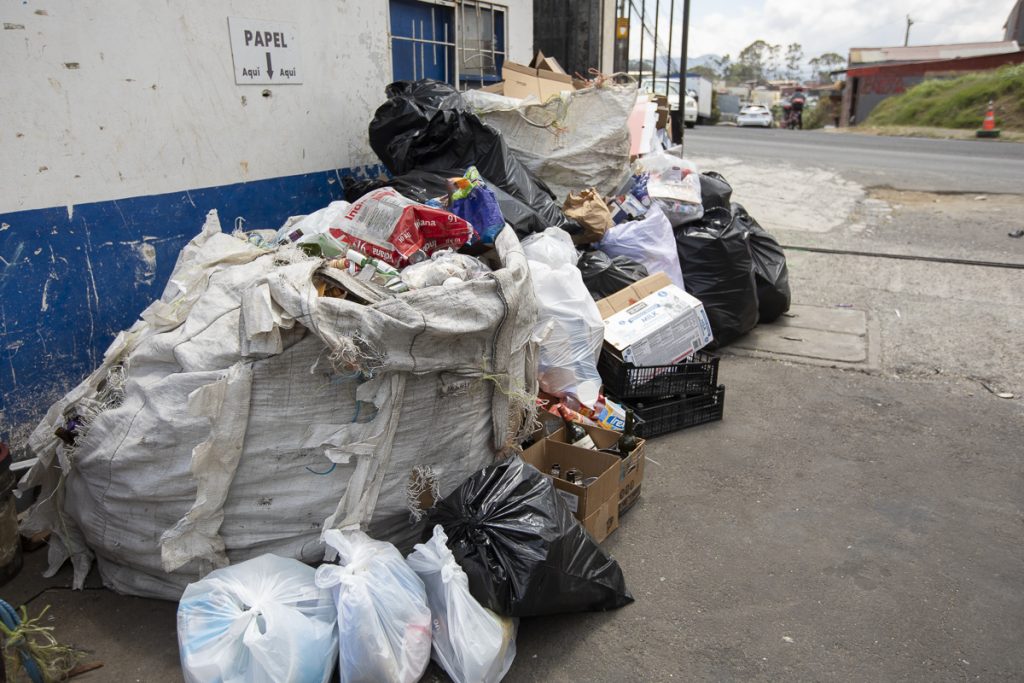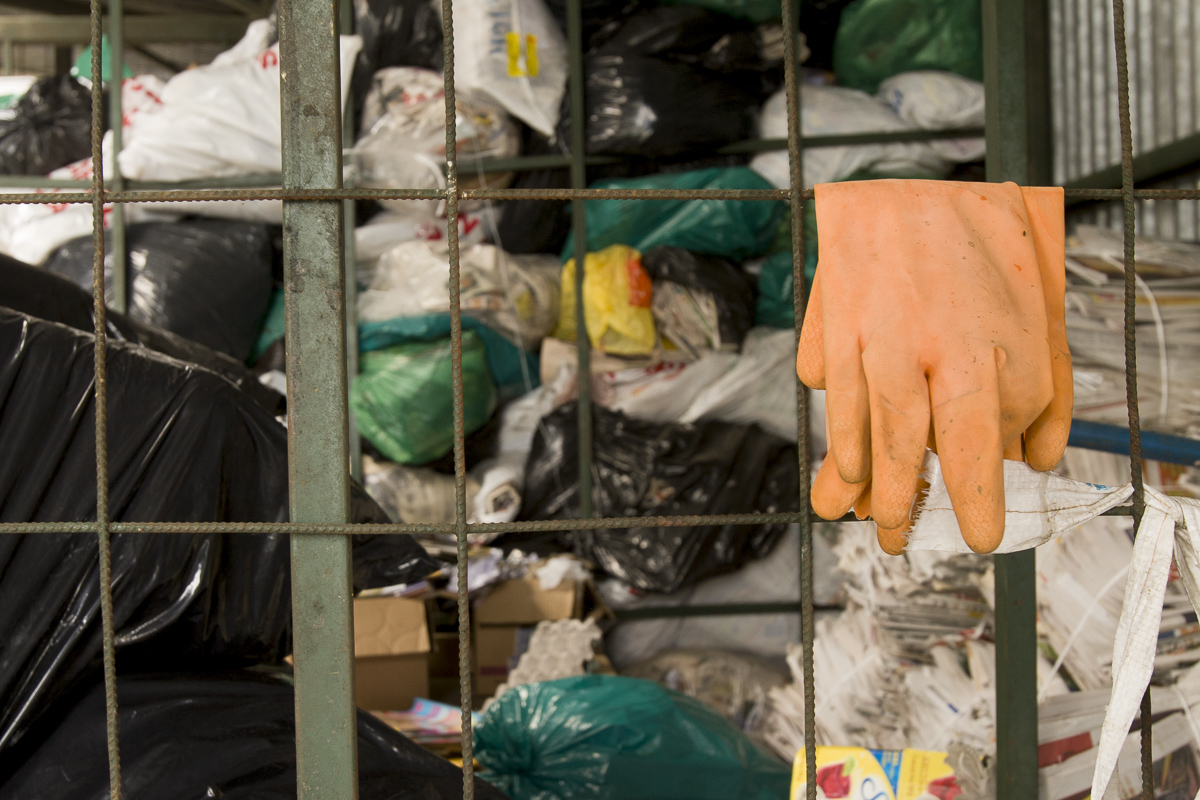The short and well-known answer is: very little.
Alarms have been sounding in Costa Rica this year about how our landfills are about to collapse, when much of that garbage could be revalued; the Executive Branch even emphasized the critical nature of this emergency in a press conference last week. At the same time, it has been widely reported that our country recycles much less than, for example, other OECD countries, which recycle an average of 33% of their waste.
And how is the world in general? According to the most recent report from the United Nations (UN) Environment Programme, entitled Beyond an Age of Waste, Global Waste Management Outlook 2024, only 19% of municipal solid waste is being recycled worldwide. This includes metals, glass, paper and cardboard, some plastics and biodegradable materials for composting. According to this same report, 11% of solid waste is recycled in Central America and the Caribbean. Even for this measurement for Central America and the Caribbean, Costa Rica is below average.

In 2016, a report by the Comptroller General of the Republic on an audit of Costa Rica’s municipalities—there were 81 of them at the time—included data on “the accessible, selective, periodic and efficient provision of the ordinary waste collection service.” That report says that until 2014, “only 1.26% [of waste generated] was being recovered. That is, of the 961.5 thousand tons collected that year, 12.1 thousand tons were recovered for valuation. The remaining 949.4 thousand tons were sent to landfills and landfills.”
The “Action Plan for the Comprehensive Management of Solid Waste 2019-2025” from the Executive Branch stated that the numbers had improved since 2014: it said that for 2016, the recycling of ordinary waste represented 3.28%, and for 2018 it represented 4.2%.
And according to the most recent official data from the Ministry of Health, by 2021 that percentage of waste recovery increased to 9.6%, of which 3.9% was destined for recycling, 2.7% for composting and 2.4% for co-processing, which is the use of waste as raw material or as a source of energy.
According to the National Policy for Comprehensive Waste Management 2023-2033, presented on April 5 by the Ministry of Health, “for the first half of 2023, the percentage of recovered waste reached 16.94%, according to reports presented by the authorized managers for comprehensive waste management and presented in the Physical-Financial Report of the first semester by the Ministry of Health.”
However, the total amount of ordinary waste generated in Costa Rica has also been increasing. According to the Comptroller’s Office, the country generated 949,417 tons of waste in 2014. By 2021, according to the Ministry of Health, the number reached 1,618,533. That’s an increase of 70% in seven years, according to a document called “State of integral waste management in Costa Rica,” a reference for the new national policy.
That new policy says that, according to the 2022 National Household Survey from the National Institute of Statistics and Census (INEC), 91.54% of the country’s waste are processed through collection. The other 8.35% end up in creeks, rivers, the ocean, or empty lots, or are burned.
Two of the main goals of the recent National Policy for Comprehensive Waste Management 2023-2033 are that by 2033, 25% of the “waste generated is recovered,” and that only 6% of homes nationwide have “inadequate waste disposal practices.”
Is this possible?
‘What motivates people to recycle? And what keeps others from doing it?’
This question about motivation was posed by a resident of Nicoya, Guanacaste, out of the 247 people from all over the country who responded to our National Recycling Survey. Of this group, only 84.2% said they actively participate in recycling. That is, even within the group of people who took 10 minutes of their time to answer our survey, there are people who still do not recycle.
People pointed to a wide range of motivations for recycling. In our survey, 87.4% said they do it to protect the environment, and 49.4% said they do it to throw away less trash. A person from Heredia said it raises awareness “about the management of my waste;” a person in Curridabat, San José, said that “it is mandatory in the condominium;” and someone in Escazú, San José, said the motivation is “reuse of limited resources.”
We also asked them what prevented them from recycling more. Most people answered that nothing is holding them back, but 16.2% said that their municipalities do not collect recyclable materials. For 13.4%, the problem is that the collection centers are too far away; 5.3% said that they still do not know what is recyclable and what is not; and 5.3% said, “I don’t like accumulating these materials in my house. I prefer to have them taken away with the trash.”
The proper management of the waste we generate is ultimately a shared responsibility, as stated in the Law for Comprehensive Waste Management No. 8839: “comprehensive waste management is a social co-responsibility. It requires the joint, coordinated and differentiated participation of all producers, importers, distributors, consumers, and waste managers, both public and private.”
Therefore, Costa Rican households—generators of 82% of ordinary waste, according to the Ministry of Health—are responsible for learning to separate our waste in order to begin the recycling chain. But is that where our responsibility really ends?
“The biggest problem we have is that we take out the waste, recoverable or not, and that’s as far as it gets. I don’t know if the truck took it, or a dog. And from that point on, what happens?” says Paola Solano, Environmental Project Manager at the Aliarse Foundation.
According to the UN report, the success of recycling processes requires appropriate collection and transportation, which necessarily requires energy resources. Therefore, the positive impact of recycling is much lower than reducing consumption.
“Recycling is not the ultimate goal of waste management. It is always better to reduce waste first,” states the UN.
“El reciclaje no es el objetivo final de la gestión de residuos: siempre es mejor reducir los residuos previniéndolos en primer lugar”, dice la ONU.
‘Sometimes I’m not sure what’s recyclable and what isn’t’
Our survey revealed another information gap: one about the final destination of materials that are sent or left for recycling. Do they really end up being recycled?
We want to know! Especially the people who spend time every day cleaning, drying, separating, and delivering reusable waste in Costa Rica. Could it be that this effort really moves the needle? Does it make any difference in the health of our environment?
“I don’t know what materials are recyclable in Costa Rica, and I’m not sure I understand the packaging nomenclature,” one person from Escazú, San José, told us in our survey. “And sometimes I doubt that everything I recycle is processed; I worry that it ends up in the trash as if it were nothing. Recycling is an effort.”
This comment was repeated in many of the responses, demonstrating that although there is legislation in Costa Rica that forces us all to include recycling as part of the comprehensive management of our waste, education programs fall short. Even those who are interested don’t really know what to do.
We asked our audience how confident people were that the material they prepare for recycling is actually recycled: 65.2% said they were almost positive, 22.7% said they had their doubts, and 12.1% said they had no idea.
What organizations and companies participate in recycling in Costa Rica?
Paola, from the Aliarse Foundation, explains that recycling processes in Costa Rica are complex, with a long value chain full of intermediaries.
“We might have a street or wheelbarrow collector, who sells it to someone with a little truck and then to another collection center, and then to a transporter, and this to another larger collection center, and then to an exporter,” says Paola. Her work at the foundation promotes the improvement of these chains, especially to benefit those people who are carrying out the collection work.
When we asked in our National Survey what recycling options people had access to, 65.2% said they use their municipality’s recycling program, which periodically collects materials (weekly, biweekly or monthly).

For 17.4% of the people surveyed, the solution is to take the material themselves to the municipal collection centers, because their municipality doesn’t pick them up.
Another 26.7% take their recyclable materials to private collection centers, and 24.3% deliver the materials to people who pass by the houses collecting.
However, there are always those who have no options.
“I don’t know. We are always looking for where to go to leave recycling materials,” a person from Santa Ana, San José told us. “We take them to the collection center of another municipality,” said a person from Alajuelita, San José.
“They should be taken to the municipal council, but everything is mixed up there. It is sad to leave all my work of many days in a place where it does not seem that they are going to be processed properly,” said the last person to respond to the survey, a resident of San Ramón, Alajuela.
According to the Comptroller General of the Republic and its Municipal Services Management Index (IGSM) 2023, 84% of all residential and commercial units in Costa Rica have access to a differentiated collection service for recoverable waste. That’s a considerable increase compared to the 58% reported by the IGSM 2021. This coverage represents actions in 61% of the country’s districts. That might seem like a low number, but it’s high considering that only 75% of the country’s districts have coverage from the municipal solid waste collection service. That is, most of the districts with solid waste collection, also offer recoverable waste services. (Use this interactive tool from the Comptroller’s Office to see the status of your canton.)
The entities that work in waste management—individual and institutional, public and private—all fall under the leadership of the Ministry of Health. What does it mean to be a waste manager? According to the Ministry of Health, the law says that waste management includes collection, transportation, storage, recovery, disassembly, export, treatment, and final disposal of waste.
All companies and organizations that have registered as managers of one or more of these mentioned actions appear on an interactive list of Approved Waste Managers, which has 2577 records and names of 551 companies, according to our count at El Colectivo 506. By consulting this list, you can find managers who carry out collection, transportation, storage, preparation for recovery, valorization, export, import, treatment and/or final disposal of waste, filtering the list according to their canton and district.

Why bother to recycle?
“Without a doubt, recycling is important for the environment, but the social impact behind it is even greater for me,” says Paola. “At the national level, we work with approximately 700 people who work directly in collection centers. Of these people, almost 60% are female heads of household. Recycling allows a single mother, for example, to go and drop off her daughter or son at school and then go to work, sort [recyclables] for a while. Then she can go get [her kids] and work a bit more in the afternoon. They are very important economic supports, with flexible schedules. For me, this is the most magical part of recycling.”
Although recycling has a positive impact on the environment and the economy, it is still an inefficient resource when it comes to reducing the negative environmental and economic impact of waste generation. The UN points out that recycling should not be the primary objective of proper waste management, since it is always better to work on preventing the generation of this waste in the first place.
Many of the people who participated in our national survey agree with the UN.
“It’s not the solution to the problem, and it can serve as a pretext for not reducing consumption and reuse, which is encouraged less or not at all,” said a resident of Santa Cruz, Guanacaste. “Where does the real interest in promoting recycling and its enormous cost come from? For example, analyzing whether the consumer and packaging generating sector promotes recycling out of interest in maintaining consumption without creating a feeling of guilt in their clients. They’re saying that recycling is a solution to a problem that they themselves promote.”





